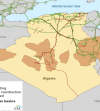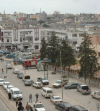The development of the textile sector in Jordan dates back to the free trade agreement signed in 1996 with the United States. In the same year, in order to promote peace for the region, Congress announced the creation of Qualifying Industrial Zones (QIZ) in Jordan, industrial free zones whose production is intended to be exported to the United States exempt from customs duties.
However, to be eligible for this exemption, 11.7% of the estimated value of the product must come from Jordanian inputs, 8% from Israel, and the remaining 15.3% from a combination of inputs from the QIZ, Israel, the United States, the West Bank and/or Gaza. Textiles have thus become Jordan’s leading export item. In 2023, textile exports represented 17.2% of total national exports for an amount of 1.4 billion JOD (2 billion USD), up +28.2% compared to 2016, when they reached 1.1 billion JOD (1.55 billion USD). 78% of exports were to the United States.
Canada (50 M JOD / 63 M USD) and the United Kingdom (38 M JOD / 48 M USD) were respectively the second and third destination countries for textile exports. However, the Kingdom is struggling to break out of a model that contributes little to its economy. In 2023, the textile industry represented 10% of manufacturing production. However, with an added value of 1.2 billion USD, the sector contributed only 2.4% to GDP. Production costs, in particular, are particularly high. Raw materials, which represent 60% of the total production cost, are imported and do not benefit from customs duty and tax exemptions in Jordan. According to the Jordan Strategy Forum, the taxation on raw materials would reduce the sector’s contribution to GDP by USD 60 million (or -0.05%), reduce employment opportunities for Jordanians (around 4,000 jobs) and be responsible for a loss of investment of around -15%.
The industry also relies on a foreign workforce (70% of employees in the sector) and a majority of women (67.3% of employees) in a context where the unemployment rate is high (21.9% on average in 2023) and where the participation rate of women in the labor market is 14%. To boost local employment, in 2017 the government introduced incentives (provision of land, rent exemption, subsidies for the employment of Jordanian personnel and mobility, contribution to employee social security) for the creation of “satellite units” outside the QIZs, closer to the cities.
The share of Jordanian employees in the sector thus increased from 17% in 2010 to 30% in 2023. In 2022, the Jordanian government ranked the sector as a high-potential industry in its Economic Modernization Vision, with the objectives of increasing exports by 3 or 4 and creating 149,000 jobs for Jordanians by 2033. It also intends to develop the production of raw materials on the national territory and set up professional training to strengthen the skills of the Jordanian workforce. Source: French Embassy in Jordan








Réagissez à cet article